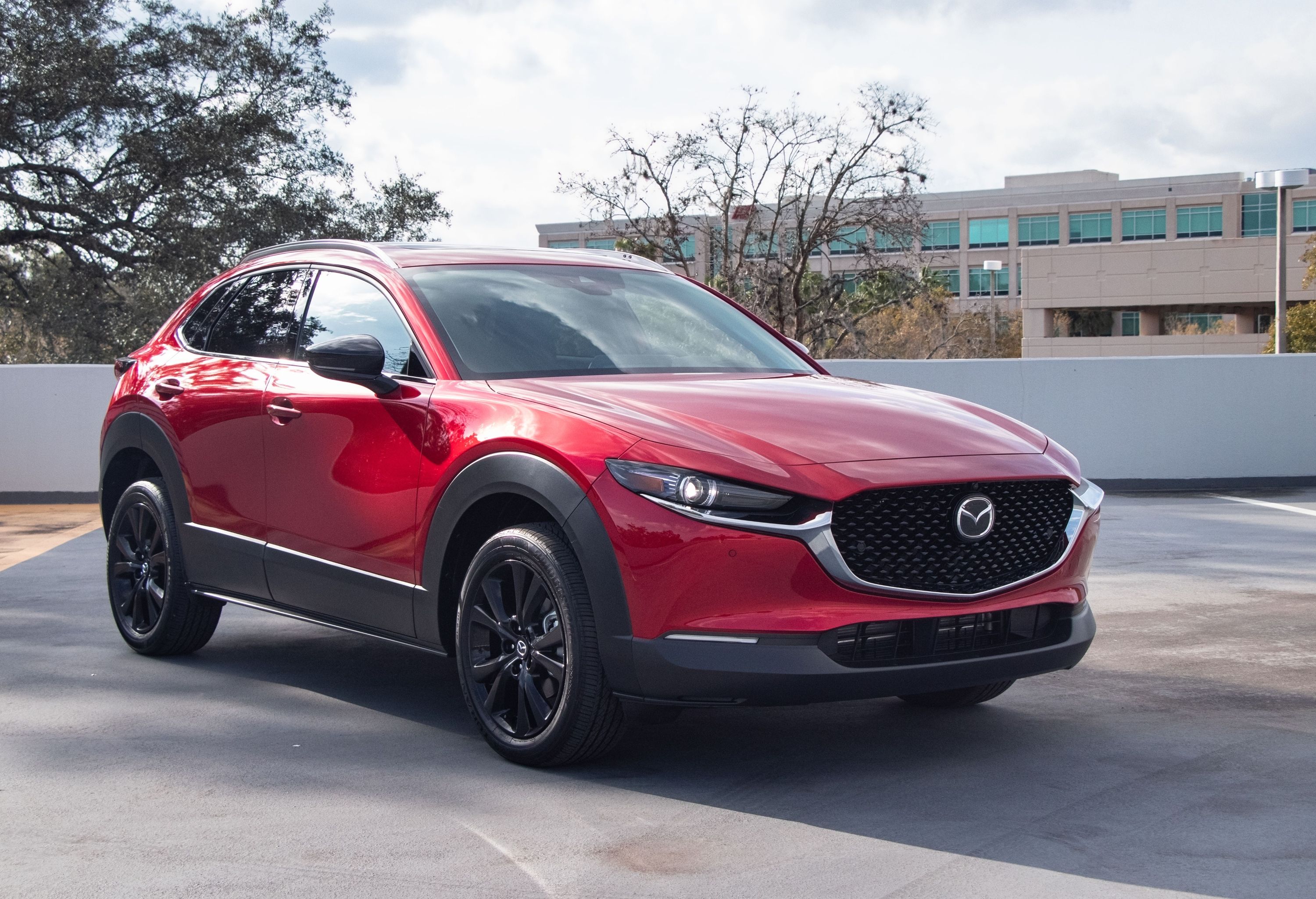
Mazda typically keeps its model lineup tight, with a vehicle for every significant segment.
Compared to brands like Toyota or Hyundai, its lineup looks anemic. Still, there are benefits to not confusing customers and concentrating on doing a few things well rather than spreading the design and engineering teams thin. However, things have changed recently, with Mazda starting to chase the American market.
The CX-3 subcompact SUV was too subcompact for the American market, which wants legroom for people in the back. The CX-30 stepped in to replace the CX-3 in the US with extra space for rear passengers and new engine choices. It has narrowed the gap between the Mazda sub-compact and compact crossover models to the point of creating some confusion.
So, let's get some clarity with a Mazda CX 30 Vs. Mazda CX-5 comparison. For additional clarity, the photos below are of the CX-30 first and the CX-5 second. The CX-50 is a different enough vehicle that we're leaving it out of this comparison.
Dimension, Interior, And Cargo Space
The CX-5 has a 106.2-inch wheelbase, and its total length is 180.1 inches. The CX-30's wheelbase isn't much shorter at 104.4 inches, but more than five inches shorter than the CX-5. The CX-5 is just over an inch wider.
Inside, that translates to 29.1 cubic feet of cargo volume for the CX-5 over the CX-30's 20.2 cubic feet. The total passenger volume for the CX-30 is 94.1 cubic feet, and the CX-5 gets 103.6 inches. Much of the measurements for the passengers are close enough to skip over, but the important one is rear passenger legroom.
The CX-30 has a decent 36.3 inches of legroom in the back, while the CX-5 gets almost over three inches more at 39.6 inches. If you have kids that have entered their teens and are growing fast, the CX-5 has more room to grow into.
Powertrains: The Same But Different
Mazda has made all-wheel-drive standard for both the CX-30 and CX-5, so the variations are in engine choices.
For the CX-5, it's either a 2.5-liter four-cylinder engine making 187 horsepower or a 2.5-liter turbocharged four-cylinder engine producing 250 hp.
The CX-30's options are a 2.5-liter four-cylinder engine making 186 hp or a turbocharged 2.5-liter four-cylinder engine making 227 hp. The two less powerful engines sacrifice a lot of pep compared to the more expensive option. If you have a heavy right foot, the CX-5's more powerful engine's 320 lb-ft of torque is noticeable.
Technology: It's The Little Things
Mazda's standard safety tech is strong, and the differences between the two are minor because the smaller car is newer. For example, the MX-30 comes with Driver Attention Alert as standard, but it's not available on the CX-5.
However, there are a few notable differences in the Mazda CX-5 vs. CX-30 technology showdown. They aren't all in the CX-5's favor, however. For example, the MX-30 comes with LED daytime running lights and brake lights, while the base CX-5 doesn't. The MX-30 has an eight-speaker sound system, while the CX-5's base system has four speakers. However, the CX-5 gets a 10.2-inch infotainment screen, while the CX-30's is 8.8-inch.
Ownership And Driving Experience
Regarding ownership, the MX-30 with either powertrain or the non-turbocharged CX-5 will be the less expensive option as the engines run on regular unleaded. It's just the turbocharged CX-5 that requires premium. On top of that, the CX-5's base engine has an EPA-estimated fuel consumption figure of 26.0 mpg combined compared to the MX-30's 29.0 mpg. If you want to stretch out filling your tank, the CX-5's 15.3-gallon tank isn't going to be much of an advantage, if any, over the CX-30's 12.7-gallon tank.
Both cars are fun to drive in general, and Mazda's dedication to driving dynamics pays off even if you're not interested in driving fast. Amongst their direct competition, there isn't anything better in that respect.
However, we're not fans of the indecisiveness and clumsiness shown by the CX-30's six-speed automatic transmission. We drove both models almost back-to-back this year, and in a direct showdown, we prefer the CX-5's transmission programming. It's not perfect and occasionally makes odd choices, but it's a rarity compared to the CX-30.
Pricing: Cheaper Doesn't Mean Worse For Everyone
If you're a driving enthusiast that needs a family crossover, then the CX-5 is a slam dunk, as it has more power, better transmission programming, and more space. You'll have to suck up the price of premium gas with the turbocharged engine.
For everyone else, it's not so clear-cut. The CX-30 is marginally smaller and going to be easier on the wallet. It starts at $22,950 for the base model with the less powerful engine and $33,800 for the turbocharged version. Alternatively, the CX-5 starts at $26,700, while the turbocharged model starts at $36,850.
For those that don't expect to have many people in the back seats and want a small, stylish, and comfortable commuter car that does everything well or well enough, the CX-30 with the non-turbocharged engine is a winner. The same goes for families with small children that expect to upgrade their vehicle in five to eight years.
The only reason to go for the turbocharged engine is if there will be a lot of freeway miles involved, and the extra power will make life easier. For those with older kids or who regularly cart friends or coworkers around, the CX-5 makes more sense.
That's about as simple as we can boil things down to. From there, it's all about budget and trim levels.
